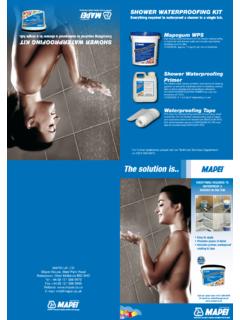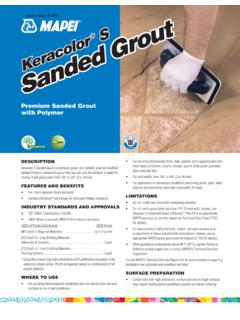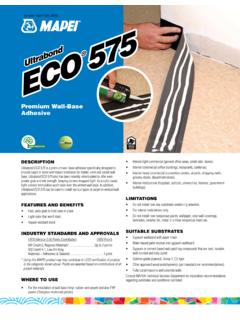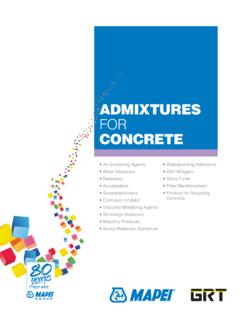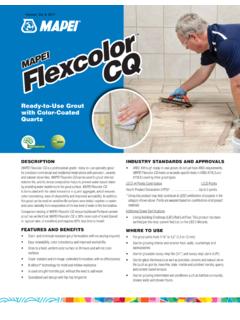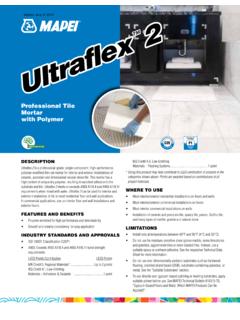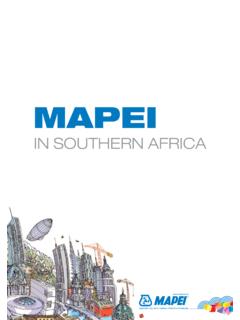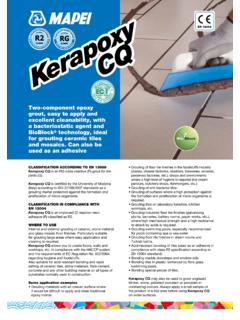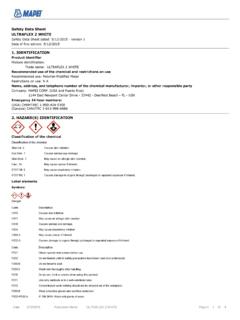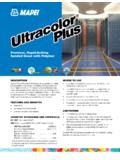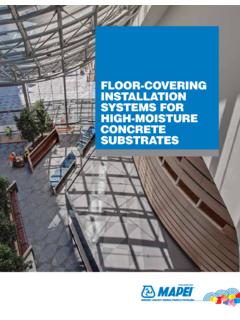Transcription of Surface-Preparation Requirements for Self …
1 Reference Guide RGF0214 This guide is specifically for mapei self - leveling underlayments. For questions regarding Surface-Preparation Requirements for mapei self - leveling toppings, such as Ultratop , please contact mapei s Technical Services Department. JOBSITE EXAMINATIONB efore work commences, examine the areas to be repaired and/or covered and report any deficiency or adverse condition in writing to the general contractor, owner, developer, architect, engineer or designer. Do not proceed with the work until surfaces and conditions comply with the Requirements indicated in the flooring manufacturer s written instructions; applicable industry standards; federal, state/provincial and local regulations; and good work practices. By beginning work, the applicator/user acknowledges that the conditions are acceptable for CONDITIONSSelf- leveling underlayments are for interior use only.
2 In areas where the finished flooring will be ceramic tile and/or stone, install mapei self - leveling underlayments in areas meeting Tile Council of North America (TCNA) Res1, Res2, Com1 and Com2 classifications. In areas where the finished flooring will be resilient flooring, refer to ASTM F710 and ACI standards. For product recommendations concerning leveling in wet areas or exterior areas, contact mapei s Technical Services Department. SURFACE preparation 1. All substrates must be structurally sound, dry, solid and stable. The substrate should be clean and free of dust, dirt, oil, grease, wax, soap, paint, concrete color stains, curing compounds, concrete sealers, clear coats, loosely bonded toppings, old adhesive residues (unless otherwise recommended by mapei ), and any other substance that may prevent/reduce adhesion or affect product performance.
3 Mechanically abrade and clean the substrate to completely remove any bond-inhibiting contaminants or conditions. Warning: Do not sand or remove any cutback adhesive that contains asbestos fibers. For removal instructions, refer to the Resilient Floor Covering Institute s Recommended Work Practices. Follow all local, state/provincial and federal regulations as well as industry standards when mechanical removal is required. Note: Chemical removal methods are not recommended. If concrete has already been chemically abated, refer to Section 4 in this guide. Maintain environmental conditions throughout the installation process. Refer to mapei s Technical Data Sheets (TDSs) for the recommended application temperature range. Exhaust any temporary heaters to the building s exterior to prevent damage to the installation from carbon dioxide emanations.
4 Turn off all forced ventilation (turbo fans and floor fans) and floor-heating systems before installation. If the floor-heating system is the only form of heat in the building, use space heaters as needed to achieve the minimum temperature Requirements . All mapei self - leveling underlayments require the use of one of the mapei primers. Consult Reference Guide RGC0609 for primer selection. Also refer to current TDSs for Concrete (General) The use of an appropriate mapei primer is required. Consult Reference Guide RGC0609, Primers for self - leveling Materials Product Selection Guide, for primer selection. Refer to current TDSs for details. The specific composition of the concrete should be in accordance with the guidelines and practices of American Concrete Institute (ACI) standards. The concrete should have a density of at least 100 lbs.
5 Per 1 cu. ft. (45,4 kg per 0,028 m3). Concrete must be installed over an acceptable and effective vapor barrier per industry standards. (This recommendation refers to on-grade and below-grade concrete slabs.) This barrier must be resistant to deterioration as well as to puncturing during construction, and must remain intact and Perform several alkalinity tests; pH levels between 5 and 11 are acceptable. Consult mapei s Technical Services Department for product recommendations for correcting pH levels outside this range, and correct any areas that are below or above this range. Refer to TDSs for details. Bonding issues may exist with concrete floors containing a supplementary cementitious material such as but not limited to fly ash with a content of 20% or higher, with concrete containing admixtures and with concrete that has a hard-troweled finish.
6 For these reasons, a bond test should always be performed to confirm an adequate bond. If an adequate bond cannot be achieved, the concrete surface should be abraded by mechanical or chemical means (such as mapei s Planiprep SA). Additional bond tests should be conducted; if an adequate bond cannot be achieved, contact mapei s Technical Services Department. Depending on the final surface profile, various floor coverings may be installed directly (using the appropriate bonding materials) or the surface can be made suitable by any number of mapei Surface-Preparation products. Consult the specific TDSs of these products for the most current and complete When applying mapei self - leveling underlayments over concrete, honor all expansion and movement joints. Provide additional expansion joints where specified, including but not limited to the perimeter of the room, columns, supports and equipment pedestals.
7 Use self -adhesive foam weatherstripping or sill plate foam to form the perimeter expansion joints. Do not bridge expansion or moving joints. Ensure that such joints are honored completely through the primer and leveling system. In areas where the finished flooring will be ceramic tile and/or stone, refer to TCNA Detail EJ171 for guidelines on movement joints or Terrazzo, Tile & Marble Association of Canada (TTMAC) Specification Guide 09 30 00, Detail 301MJ. In areas where the finished flooring will be resilient flooring, refer to ASTM F710 and ACI When applying mapei self - leveling underlayments over existing non-moving control joints, mark the control joints on nearby columns and Surface-Preparation Requirements for self - leveling UnderlaymentsFloor Covering Installation Systemswalls. When the self - leveling underlayment is dry enough to be walked upon, use a grinder to restore saw-cut joints into the self - leveling underlayment.
8 Reference the markings for proper Concrete slabs have the tendency to expand, contract, shift and move due to curing, temperature changes, seasonal changes, ground settlement, heavy loads, vibration and the Earth s natural forces. When dealing with existing cracks, consult with an experienced engineer to determine appropriate crack-repair procedures. mapei does not warrant against concrete slab movement or against moisture coming up through cracks. 3. Concrete Moisture Concrete moisture testing must be performed before the application of mapei self - leveling underlayments and All concrete substrates must be fully cured and free of any hydrostatic Inspect jobsite conditions around the exterior of the building. Consider whether foundation plantings, mulch beds, sprinkler systems, gutters and drainage issues may cause seasonal moisture problems or sporadic elevated moisture conditions inside the All concrete, regardless of age or grade level, has a certain degree of moisture and pH that should be analyzed and taken into account before the installation.
9 Two industry-accepted methods are used to evaluate the presence of moisture in concrete slabs: the Calcium Chloride Test Method and the Relative Humidity (RH) Moisture Probe Test Method. Note: Pin meters commonly used to measure the moisture content of wood flooring are not acceptable tools for qualifying a concrete slab to receive a self - leveling underlayment. Calcium Chloride Test Method (ASTM F1869) Standard Test Method for Measuring Moisture Vapor Emission Rate (MVER) of Concrete Subfloor Using Anhydrous Calcium Chloride. When using the Calcium Chloride Test Method, if the concrete slab measures more than 5 lbs. per 1,000 sq. ft. (2,27 kg per 92,9 m2) per 24 hours, mapei also recommends an RH Moisture Probe Test. Follow the most current instructions set forth by ASTM F2170. RH Moisture Probe Test Method (ASTM F2170) Standard Test Method for Determining Relative Humidity in Concrete Floor Slabs Using in Situ Probes.
10 When using the RH Moisture Probe Test Method, if the concrete slab measures more than 80% RH, mapei also recommends a Calcium Chloride Test Method. Follow the most current instructions as set forth by ASTM F1869. All components in the flooring system (primers, levelers, membranes, setting materials, adhesives and the flooring itself) should be considered regarding the maximum allowable MVER and/or RH. Consult individual TDSs regarding the maximum allowable MVER and RH for all mapei products. Refer to the flooring manufacturer s written instructions for the moisture limits of the flooring material. Work should not begin if the maximum allowable MVER and/or RH exceeds mapei s or the flooring manufacturer s moisture limits. For such a case, refer to Step Use a mapei epoxy moisture barrier to treat concrete slabs with elevated moisture conditions.
